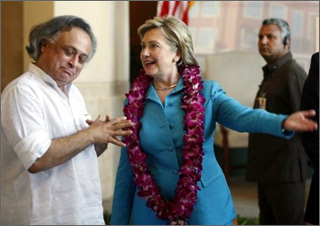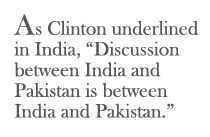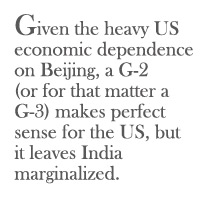New Configuration of Obama’s Asia – Part I
New Configuration of Obama’s Asia – Part I

LONDON: The long-awaited visit by US Secretary of State Hillary Clinton to India provided the usual public affirmation of “India being a vital partner of the US in building a stable international order.” But there was no mistaking that the thrill is gone. The cooling of the strategic partnership built by the Bush administration, which conferred on India the de facto nuclear weapon state status, introduces new uncertainties in Asia. With the balance of power in Asia shifting amid talk of a G-2 between the economically hobbled US and the rising giant China, a loosening of the Indo-US bond could produce unpredictable consequences far beyond the Indian Ocean.

Of course, the Indo-US relationship losing some of its Bush-era sheen does not underestimate the value of the relationship to both sides. Economic and defense ties are on an upswing with the US and India finalizing the End User Verification Agreement that will allow US companies to sell sophisticated arms to India. Lockheed Martin and Boeing will be bidding for one of the largest arms deals in the world – India’s plan to buy 126 multi-role fighters. Clinton also announced two sites where American firms would have the exclusive rights to build nuclear power plants. Space cooperation got a boost with the signing of an agreement that facilitates the launch of US satellites and satellites with US components on Indian launch vehicles. Bilateral trade is growing. And India will be an even bigger source of migration to the US in the coming decades. The Indian community in America is becoming ever more effective in leveraging their influence towards promoting bilateral ties.
But Washington and Delhi’s malaise was not dispelled by Clinton’s sweet words. The growing uneasiness is as much the result of administration change in Washington as it is of the economic crisis affecting the US. George W. Bush, deeply suspicious of communist China, was personally keen on building strong ties with India. Hence, he was willing to sacrifice long-held US non-proliferation concerns to embrace nuclear India and acknowledge it as the primary actor in South Asia, de-hyphenated from Pakistan. The Obama Administration’s concern with protecting the non-proliferation regime, dealing with the immediate challenge of the growing Taliban threat in Afghanistan and Pakistan, and solving the unprecedented economic challenge have led it to a very different set of priorities and an agenda in which India has a marginal role. The only context in which Obama has mentioned India thus far was the need to resolve Kashmir so as to find a way out of the West’s troubles in Afghanistan. Talk of a strategic partnership between the two democracies has all but disappeared.

Still, the Obama administration has been trying to rectify some its earlier mistakes. It has since tried to clarify that the US was neither trying to “negotiate” a dialogue between India and Pakistan nor pressure the two to resume bilateral talks. As Clinton underlined in India, “Discussion between India and Pakistan is between India and Pakistan.” But such rhetoric has not changed India’s feeling that despite its great restraint in the aftermath of Mumbai in dealing with Pakistan, the new administration seems intent on sidelining Indian concerns.
Nothing perhaps highlights the shift in the relationship more than Obama’s deep concern about strengthening the non-proliferation regime. It is troubling for India that it was the Obama Administration that effectively persuaded the G-8 countries to issue a declaration at the recent summit in L’Aquila committing the advanced industrial world to implement on a “national basis” the proposals to strengthen controls on enrichment and reprocessing (ENR) items and technology contained in the Nuclear Supplier Group meeting. This latest G-8 statement on banning the ENR items to countries that are not signatories to the NPT (which India is not) has raised questions about the future of the US-India nuclear pact that promised “full civilian and nuclear cooperation” to India. Although the US never promised ENR technology to India, its role in encouraging others to deny it strengthens those in India who have always claimed that the US can never be a reliable strategic partner of India.

When the new Administration toyed with the idea of G-2, a global condominium of the US and China whereby China looks after and ‘manages’ the Asia-Pacific, this elicited strong negative reactions from US allies in the region. Hence, the US decided to change course. Now the talk is of G-3 – a forum that would bring the US, China and Japan together this month for the first time. This is primarily aimed at pacifying a Japan that felt marginalized by the growing coziness between the US and China. Given the heavy US economic dependence on Beijing, a G-2 (or for that matter a G-3) makes perfect sense for the US, but it leaves India marginalized in the strategic scheme of things. From being viewed as a rising power and a balancer in the Asia-Pacific region, India is now back to being seen as a regional South Asian actor whose only relevance for the US is in making sure that Pakistan fights the Taliban with full vigor without getting preoccupied in Kashmir. The smaller countries of East and Southeast Asia, not to mention India’s immediate neighbors who are being wooed by China, cannot but note the shifting balance of power that Washington’s maneuvering signals and thus adjust their own policies. Would the countries be as willing to build stronger ties with India if they see it being marginalized by the US? How would it affect their attitude towards the Asian behemoth in the rising G-2?

These unfavorable shifts make it more than necessary for India to find ways to ameliorate the balance of power in the region. There is some irony in the fact that when the Bush Administration wanted to woo India, domestic politics constrained India’s options. Today when there is a stronger government in New Delhi, Washington seems no longer interested. At the regional level, India needs to establish certain guidelines that any AfPak strategy would need to address. Indian security concerns are genuine and they have been ignored for far too long by the West and the US in particular despite the fact that India and the US share a common interest in the stabilization of Afghanistan and Pakistan. India cannot be expected to cooperate fully with Pakistan and thus help the US strategy in Afghanistan if Pakistan remains unwilling to dismantle the terror infrastructure in its territory targeted against India. American pressure to do more will only create a domestic backlash in New Delhi and further weaken the relations which were otherwise on a rising course.
It will also be short-sighted of the Obama Administration to downgrade India’s status. On almost all the priority issues on the global agenda – climate change, non-proliferation, trade negotiations – India remains a pivotal player and a US-India partnership is the best route to achieve favorable outcomes. The Obama Administration will have to do more than merely suggest that it understands Indian concerns. As Clinton discovered in her talks on the environment, a rising India is also a more assertive India and US foreign policy will not be able to achieve its objectives by ignoring Indian interests.
Harsh V. Pant teaches in King’s College London.